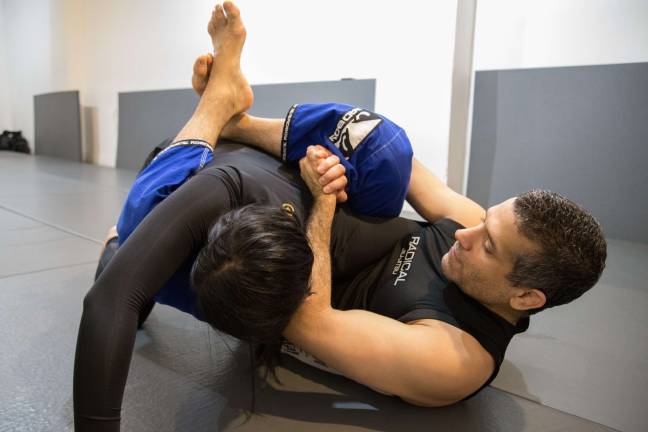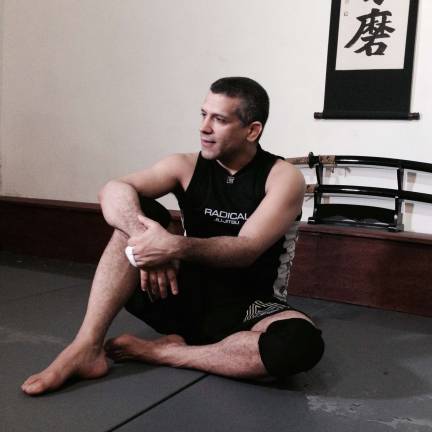the art of the fight


Anyone who enters Radical MMA in Chelsea is required to get barefoot and step onto a black pad inside a small blue rectangular bucket holding a cool sanitizer. They then step out onto a rug and descend stairs to a long, rectangle-shaped room and take a second footbath.
Only then can they walk onto the large gray mat where they’ll practice martial arts techniques or sparring for the next few hours. “Osu,” they declare, Japanese for “I will persevere through hardship.”
René Dreifuss, 47, the owner and driving force behind Radical MMA, enforces Japanese martial arts values and demands respect, discipline and a desire for self-improvement. His pupils range from amateur mixed martial arts fighters with dreams of going pro to those simply getting in shape. He says Japanese-style formalities help separate Radical MMA from other fight-training schools in New York. His students agree: Dreifuss’s approach, they say, has made them more mature, confident and tenacious in their everyday lives.
Piaras McGarry, an amateur fighter who moved to New York City from Northern Ireland last year, said he’s been surprised to find himself cursing less outside the gym since he began training there.
“Me being Irish, we like to curse every second,” McGarry, 22, said. “Training at Radical has improved my overall life in terms of my vocabulary.”
McGarry said Radical MMA, on West 29th Street between Seventh and Eighth Avenues, has more rules than any other academy he’s been to — he’s lost count of how many places he’s trained. For example, Dreifuss’s gym was the first time McGarry used a footbath.
Dreifuss said cleanliness is a huge part of Japanese culture. His other rules, printed on a sheet of paper titled “Dojo Etiquette,” include not being selfish or egotistical.
He gives students opportunities to fix any problematic behavior to meet his guidelines. If they don’t reform, Dreifuss bans them. The same goes for any first-time offender who does something unconscionable like act sexist towards the academy’s women or recklessly injuring a training partner.
Dreifuss said those are behaviors he’s seen at “meathead gyms,” which he equated to college frats. He’s witnessed fighters who practice with the same effort as they would in a fight and could potentially concuss his training partner.
“Most of the fights they get into are stupid bar brawls they could walk away from,” Dreifuss said. “That’s not self-defense, that’s ego-defense. They’re not afraid of the guy breaking into their home and putting a gun to their head. They’re afraid of being shown up in front of their bros. That’s the allure of a meathead gym. I hate that.”
Every Saturday from 10 a.m. to 2 p.m., McGarry heads to Radical MMA to train with fellow amateur fighters Marlon Wiprud and Yu Ji. As three of Dreifuss’ most experienced students, they spend hours drilling rigorous fight training while trying not to injure one another. Each man is over 6 feet tall and slightly over 200 pounds.
Wiprud said the intense workouts pay dividends whenever he’s fighting someone in the ring.
“When you and another person are trying to knock each other out in front of 1,000 people, it’s obviously a stressful situation,” Wiprud said. “When you go through a lot of stress in training, it gives you this mental edge, where you’re like, ‘There’s no way you trained harder than me.’”
The sound of thuds reverberate throughout the room as students attempt to take their sparring partners down to the mat.
Among them is Juan “Wolf Man” Jimenez, who came to Radical MMA a few years ago to get in shape. Standard gyms where the workout partners are treadmills and weights were boring, Jimenez, 28, said. He entered the academy at nearly 170 pounds — overweight.
“I used to be tired all the time,” Jimenez said. “I thought it was normal. I realized it’s not normal; I was just out of shape.”
Now, he said he fluctuates between 130-135 pounds. He achieved that goal, but has set new ones for himself after deciding to remain at Dreifuss’s school. Jimenez said he has no interest in becoming a professional mixed martial artist, but enjoys testing himself in amateur Brazilian jujitsu competitions. Those feature grappling an opponent on the ground while trying to control and submit them through either choking or extending a limb.
Dreifuss trains a handful of female students, and he’s not afraid to put them up against males in practice. Aleysa “Mouse” Yelisowa said she’s been benefited a lot in the outside world by the opportunity to train with men.
“I’m going to go into the risk management field soon, where it’s going to be mostly male-dominated,” Yelisowa, 28, said. “I don’t feel nervous anymore. Once you can fight guys, you’re not really intimidated by them in an office setting.”
She’s now even considering becoming a fighter once she sharpens up her striking: the punches, kicks, knees and elbows that mixed martial artists throw. Meanwhile, she continues to practice grappling.
Dreifuss closes out each session by reminding his students the importance of discipline. He tells students that they may find themselves passing on the knowledge of martial arts and wants them to teach the same values of respect and discipline he once learned in Japan. Dreifuss then dismisses the class.
“Osu,” the students shout in unison.